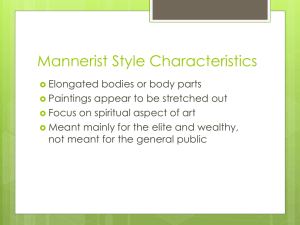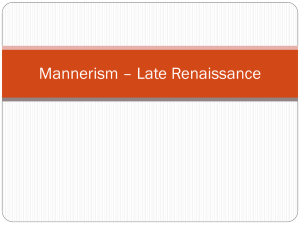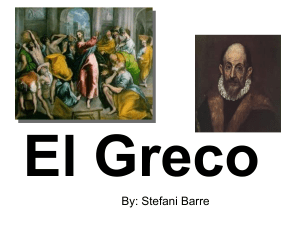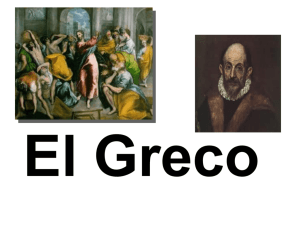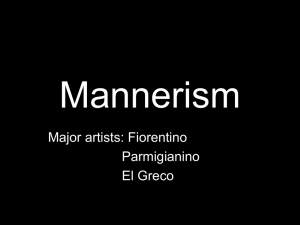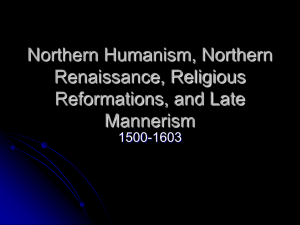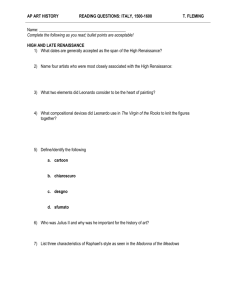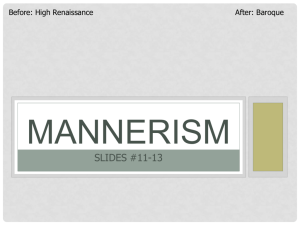Northern Renaissance
advertisement
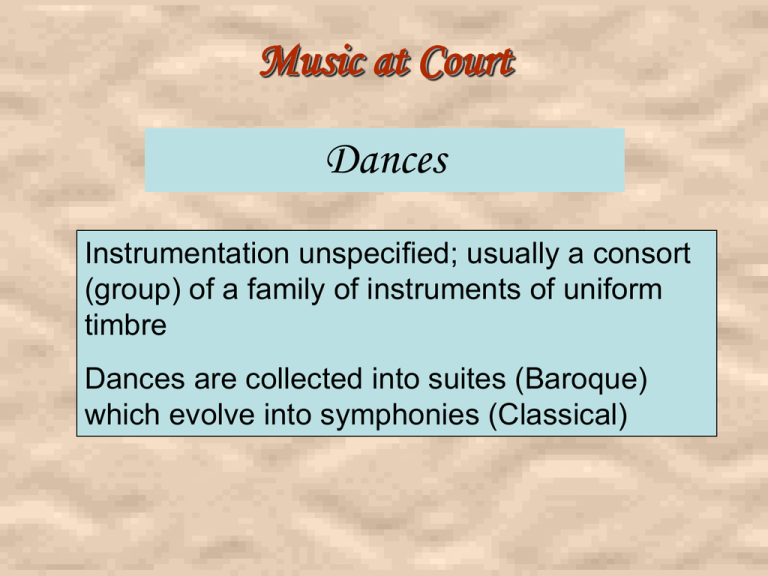
Music at Court Dances Instrumentation unspecified; usually a consort (group) of a family of instruments of uniform timbre Dances are collected into suites (Baroque) which evolve into symphonies (Classical) Music at Court Listening example – La Bouree Key info: • a family of instruments of uniform timbre • Dance music from the Renaissance Extra info: • La Bouree (title & type of dance) by Michael Praetorius (c. 1571-1621) • German composer of international fame •http://www.youtube.com/watch?v=_XvVtszPyTs Crumhorn – an instrument from the Renaissance http://www.music.iastate.edu/a ntiqua/instrumt.html Music at Court Madrigals Origin of term obscure A type of song (see text for longer definition) for multiple voice parts Text is a rhyming poem, usually with sections of repetition & is usually about Love Music at Court Madrigals popular-at-court-&-wealthy-homes music in Italy & England – in some ways a “popular” music, but participatory Madrigals: text-painting importance of words homorhythmic texture chords Listening example - madrigal Music at Court Key info: • a madrigal • Note homorhythmic texture & repetitive structure. Chords begin to function as musical units, rather than as the byproducts of independent contrapuntal lines. Be able to identify period – Renaissance • secular vocal music from the Renaissance Now Is the Month of Maying, 1595 •http://www.youtube.com/watch?v=LJ7VirCScp0&feature=related • Thomas Morley (1557-1603) most famous Composer mentioned Music at Court Listening example - madrigal Key info: • a madrigal • TEXT PAINTING • secular vocal music from the Renaissance Thomas Weekles (c. 1575-1623) • title: As Vesta Was Descending, 1601 (relate to Elizabeth I, reigned 1558-1603) • http://www.youtube.com/watch?v=S_VkA_qk9os&feature=related Shakespeare Part of a general revival of theater, which we need to mention now, because OPERA is about to develop in the Baroque period. HAMLET - 1602 Globe Theater Globe Theater Today Inventions of the Renaissance/Reformation/Baroque Clocks The oldest surviving mechanical clock were made in the 1300’s. , Italian scientist Galileo discovered the pendulum. , This made for better time keeping. , Water clocks and hourglasses , Water clocks and hourglasses were widely using in the 1500’s. The Watch (portable timepiece) The portable watch was invented by German Peter Henlein in 1505 , He created his watch to be spring powered making it much smaller. , This watch was a pocket watch. The wrist watch didn’t come into widespread use until the 1800’s. , Printing The Chinese were the first to invent printing in 868. , In the mid-1400’s, Johan Gutenberg of Germany invented a printing press using moveable type. , Now books could be printed with greater speed and less effort. , The Gutenberg Bible is considered one of the first books ever printed. , Printing Press , The printing press, invented by Johannes Gutenberg, played a crucial role in advancing the Reformation by allowing for wide distribution of Reform ideas and making the Bible a best seller. Luther’s translation of the text into vernacular German was chief among many editions, and Luther himself was the Continent’s best-selling author. Other humanist writers, notably Montaigne and Rabelais, took advantage of print to distribute their own works. Montaigne invented the personal essay, a vehicle for testing ideas even as they are written. Illustrated books were also popularized through print. Albrecht Dürer produced many single-sheet engravings to be sold inexpensively as individual works of art. Eyeglasses Eyeglasses were invented in the 1300’s. , With the invention of the printing press in the 1400’s, the demand for eyeglasses increased. , Far-sighted glasses (for reading) were developed first. , Later on near-sightedness was able to be corrected. , Lenses Lenses were used for more than just eyeglasses. , Galileo used lenses to make an astronomical telescope to look at the stars and planets in 1606. , Isaac Newton made the first reflecting telescope in 1668. , The Musket , , , , , The musket was the first usable rifle that soldiers could carry into battle. It was developed in Spain in the 1500’s. It could fire a metal ball that could seriously kill or hurt someone. The first muskets were very large weighing 40 pounds and being over 6 feet long. They were very hard to use. The Rudder , The invention of the rudder in the 1200’s greatly increased the control over steering a ship. The Flush Toilet , , The flush toilet, or water closet as it was called dates back to 1589 when it was invented by Sir John Harington. Harington invented a valve that when pulled would release water from a water closet. Sir John recommended flushing the toilet once or twice a day, although with our modern technology, we know that is probably not sufficient. (Rumor has it that, in Robin Hood's day, King Arthur - angry with how his brother ruled the country while the King was gone, named the toilet, 'the john' - aka as 'the jon' to you folks.) Adding Machine , The French scientist, Blaise Pascal has been credited with inventing the very first digital calculator. In 1642, the 18-year-old Pascal, the son of a French tax collector, invented his numerical wheel calculator called the Pascaline, to help his father count taxes. Thermometer The Thermometer was invented by Galileo in 1593 which, for the first time, allowed temperature variations to be measured. In 1714, Gabriel Fahrenheit invented the first mercury thermometer, the modern thermometer. , Thermometers measure temperature, by using materials that change in some way when they are heated or cooled. , Submarine The submarine was invented in 1624 by a man named Cornelius van Drebbel. , Leonardo da Vinci drew out the basic concept of a submarine over one hundred years before. , Drebbel, a Dutch inventor and engineer employed by the British navy constructed a leather- covered rowboat from which oars protruded through watertight seals. , Drubbel's ship could stay underwater for a few hours, but it only went about fifteen feet under the surface. , The Match , , , , Fire - our worst enemy, our best friend - was difficult to create until Robert Boyle invented the match in 1680. Although fire could be made by rubbing sticks together or by striking flint to steel, this was a time consuming process. Boyle discovered that when phosphorus and sulfur were rubbed together, they would burst into flame. Although convenient, Boyle's matches were not very safe, because sometimes they accidentally went up in flames while in a pocket. (Warm surprise!) With some improvements and a little fine tuning, this invention led to your modern safety match many years later. Back to Italy – Mannerism Mannerist Style Characteristics , , , , , Elongated bodies or body parts Paintings appear to be stretched out Focus on spiritual aspect of art Art was originally meant only for the nobility/wealthy to see – not for the general public Often obscene or offensive Mannerism (from handout) Mannerism - Post-Renaissance, Pre-Baroque style of painting and sculpture in Italy characterized by elongated, distorted and exaggerated figures. Pictorial space often crowded, complex or confusing Mannerism Madonna with the Long Neck , 1534 – 1540 , Florence, Italy , Painting , Artist: Parmagianino , Mannerist style preferred distorted figures; elongated; artificial , Figures crowded into left side – viewer is drawn to different areas of painting , Not just one focus , KEY IMAGE p 252 and this column is for what??? Parmagianino, Madonna with the Long Neck, 1534-40 Quite a crowd Little guy Descent from the Cross 1525-1528 Florence, Italy Painting - oil on wood 10 ft. 3 in. x 6 ft. 6 in. Jacopo da Pontormo Considered his masterpiece Jacopo Pontormo Descent from the Cross 1525-28 11’ x 6.5’ oil on wood p. 253 Mannerist portraits are often devoid of emotional connotation, but there is some exaggeration of physical features Pontormo Florentine, 1494 - 1556/1557 Monsignor della Casa, probably 1541/1544 oil on panel, 102 x 78.9 cm (40 1/8 x 31 in.) Michelangelo Last Judgment, Sistine Chapel 1534-41, wall fresco Mannerism , , , , , , Laurentian Library 1525-1571 Florence, Italy Michelangelo Considered the first work in the new Mannerist style Elongated, slightly out of the exact proportions of the Renaissance Laurentian Library Mannerism , , , , , , , , , , Allegory with Venus and Cupid 1546 Florence, Italy Painting Artist: Agnolo Bronzino Court painter for Cosimo I de Medici Mannerism was meant for nobility to enjoy not the general public Space full of figures Shows an oddly erotic encounter Bodies elongated and distorted Mannerism Last Supper , 1592 – 1594 , Venice, Italy , Painting , Artist: Tintoretto , If it weren’t for the halo, Jesus would be hard to find , Perspective leads away from Christ , Darker version , Judas in traditional spot on opposite side of table , Christ in the House of Levi 1573 Venice, Italy Painting - oil on canvas 18 ft. 6 in. x 42 ft. 6 in. Paolo Veronese The Venetian use of blue is still key in Mannerism – had to change name of painting Domenikos Theotokopoulos (El Greco) , , , , , , The most important Spanish artist of this period was Greek. 1541 – 1614. He deliberately distorts & elongates his figures, and seats them in a lurid, unearthly atmosphere. He uses an agitated, flickering light. He ignores the rules of perspective, and heightens the effect by areas of brilliant color. His works were a fitting expression of the Spanish Counter-Reformation. Mary Magdalene in Penitence 1577 Toledo, Spain Painting - oil on canvas 42 1/2 x 39 7/8 in. El Greco (Domenikos Theotokopoulous) El Greco was born in Greece, studied in Italy and painted in Spain – as such he is a unique painter in many ways View of Toledo 1586 Toledo, Spain Painting - oil on canvas 47 3/4 x 42 3/4 in. El Greco The most famous of the mannerist painters Paints a gloomy transparent landscape El Greco Christ in Agony on the Cross 1600s El Greco Portrait of a Cardinal 1600 Mannerism The Burial of Count Orgaz , 1586 , Toledo, Spain , Painting , Artist: El Greco , His masterpiece , Local aristocracy attends at bottom as Christ and Saints welcome his soul at the top , Elongated forms are typical , El Greco’s, The Burial of Count Orgaz, 1586-1588 El Greco’s, The Burial of Count Orgaz, 1586-1588 (details) El Greco’s, The Burial of Count Orgaz, 1578-1580 El Greco The View of Toledo 1597-1599 Mannerism , , , , , , , , Saltcellar of Francis I 1539 – 1543 Paris, France Craftwork/Sculpture Artist: Benvenuto Cellini An ornamental salt and pepper holder for the king of France Salt is represented by the sea and pepper by the earth Gold and enamel Mannerism , , , , Villa Rotunda 1567 – 1570 Vicenza, Italy Architecture Artist: Palladio , Symmetry was crucial to Palladio, even the gardens are symmetrical , All 4 sides are identical , Monticello in Virginia, Jefferson’s home was based in this building , Palladio Scala Ovata Basilica Palladio Teatro Olimpico San Giorgio Maggiore
